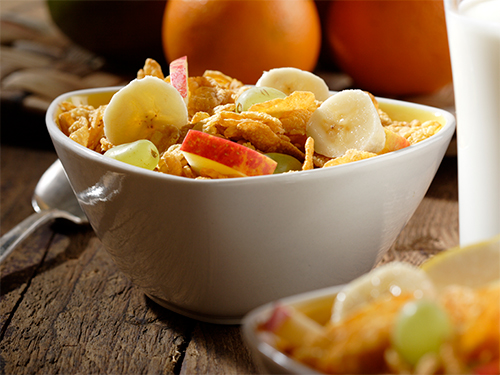
Fact Sheet FS1110
Eating together as a family as often as possible is important for growing families. The list of benefits of family meals continues to grow and includes promoting a healthy weight in young children and nurturing healthy lifestyles in older children. Studies also show that children who eat regular family meals eat more of what is good for them: fruits, vegetables, grains, and calcium-rich foods.
Family meals may be on the upswing, but recent studies show that 40% of families in the United States eat dinner together only three times a week or less, and 10% never eat dinner together. In addition, childhood obesity rates, although stabilizing, continue to be of concern. As a result, planning and making family meals that are nutrient-rich, at dinner time or anytime, is as important as ever.
What is a Nutrient-rich Meal?
There are six groups of nutrients in food that provide what our bodies need for energy and good health. These nutrients are carbohydrates, fats, proteins (only these three can provide energy), vitamins, minerals, and water. A nutrient-rich food is one that has a significant amount of vitamins and minerals, yet a reasonable amount of energy, or calories. Examples include plant foods such as vegetables, fruit, legumes and whole grains, and protein foods such as fish, poultry, lean meat, and low-fat milk products.
The opposite of a nutrient-rich food is an energy-rich or energy-dense food. These foods supply a lot of calories, but few vitamins or minerals. Examples include candy, cakes, pies, fried foods, and snack foods such as chips and soft drinks.
Nutrients Needed for Growing Children
To meet the needs of growing children and all healthy Americans ages two years and above, include a variety of nutrient-rich foods and healthy beverages in your family’s meals every day, while limiting saturated fats, trans fats, and added sugar and salt. This, along with regular physical activity, is important in promoting the future health of our children. Meeting these needs can be done with ease at family mealtime by focusing on the foods that are recommended: a variety of whole plant foods and lean protein foods, with sensible fat and beverage choices.
Choosing Whole Plant Foods
Include whole plant foods as a significant part of your family’s diet by choosing a variety of fruits, vegetables, whole grains, and legumes. These foods provide a large variety of vitamins, minerals, and other nutrients that contribute to growth and overall health.
Fruits and vegetables provide an array of health-promoting nutrients. Think color when choosing them, the more color, the better! Create your child’s plate as a new palette every day that is filled with dark green, orange, red, white, and purple fruits and vegetables. They will love the colors and you will enjoy knowing that they are eating these nutrient-rich jewels from the garden. For ease of mealtime prep, choose fresh, frozen, canned, or dried fruits and vegetables, all of which provide similar nutrient values. Aim for approximately two cups of fruit, and 2½ cups of vegetables each day, choosing more often for children whole fruits and vegetables over juice.
Whole grains, on the other hand, cannot always be identified by color. The proof is in the ingredient list. For most whole grain products, the words "whole" or "whole grain" will appear before the grain ingredient's name, ideally with the whole grain listed first. Some well-known whole grains include whole wheat, wild rice, and brown rice; but did you know that popcorn is also a whole grain? With little added fat, popcorn is a great snack that the whole family can enjoy! Buckwheat, bulgur or cracked wheat, whole-grain barley, and millet are other examples of whole grains. Experiment with a variety of them to add something delicious and nutritious to every meal. Aim for about one-half of your daily grains to come from whole grains.
Legumes, or dried peas and beans, are also a great whole plant food choice that packs a powerful nutrient punch by providing a great source of plant protein. Include them in childrens' diets early on by adding chickpeas, white, black, or red beans to casseroles, soups, and salads. Legumes also make great finger foods for the younger set. Aim for several cups each week, increasing slowly and eating with plenty of fluids, if your family is not used to the high fiber content of beans.
Choosing Lean Protein Foods
Protein is an important nutrient in the diet of growing children. Round out your family's plate with choices such as fish*, white breast meat of poultry, and an occasional egg, limiting the red meat choices of beef, pork, and lamb. Aim for choices that are lean, low-fat, or fat-free and prepare by baking, poaching, or broiling to limit added fats.
Milk and milk products are also excellent sources of protein. Recommendations for children two to eight years of age are 2–2½ cups per day of fat-free or low-fat milk or milk products, increasing to three cups per day for children 9 years of age or older.
*When choosing fish for children or women of child-bearing age, be sure to check for current recommendations from the Environmental Protection Agency at epa.gov.
Choosing Fats
Fat in the diet has received a great deal of attention over the years about not only how much fat is "ok" but also what types of fat to eat or to avoid. It can be confusing. Simply stated, saturated and trans fats are fats that should be limited in the diet of most healthy family members. An exception for this is for children under the age of two who need important fatty acids in their diets for development, so their fat intake should not be limited.
When choosing food items with fat, it is helpful to know that saturated fats are found in animal-based foods including meat, poultry, and dairy products and in some tropical oils such as coconut, palm kernel, and palm oils. Trans fats are also found in animal products, but the majority of them come from fats that have been changed from a liquid fat to a solid. Saturated fats also tend to be solid. As a result, a simple rule of thumb when choosing a fat is to choose those that are liquid at room temperature. Examples of these include vegetable oils such as canola or olive oils, which contain mostly monounsaturated fats, and safflower or soybean oils, which contain mostly polyunsaturated fats. Aim for these primarily mono- and polyunsaturated fat choices.
Choosing Beverages
For all ages, water is the recommended beverage of choice. It is important to limit sweetened beverages and juices, even 100% fruit or vegetable juice, for the benefits of water. Beverages with a high sugar content are energy-dense, with limited other benefits. On the other hand, water is an essential nutrient that quenches our thirst without the added energy that is best saved for whole food choices. Aim for 50 fluid ounces, or approximately eight cups of water each day.
Providing nutrient-rich family meals are well worth the effort to promote the health and well-being of growing children. Besides being nutritious and tasty, family meals that spotlight healthful foods are setting the foundation for the choices that your children will make when they set out on their own someday.
Try these tips to make your family meals nutrient-rich:
For more information on nutrient-rich meals, visit:
Photo credits: istockphoto.
August 2019
Copyright © 2025 Rutgers, The State University of New Jersey. All rights reserved.
For more information: njaes.rutgers.edu.
Cooperating Agencies: Rutgers, The State University of New Jersey, U.S. Department of Agriculture, and Boards of County Commissioners. Rutgers Cooperative Extension, a unit of the Rutgers New Jersey Agricultural Experiment Station, is an equal opportunity program provider and employer.



